
Suspended: A Cryogenic Nightmare is an interactive fiction video game written by Michael Berlyn and published by Infocom in 1983. Infocom's sixth game, it was released for Amstrad CPC, Apple II, Atari 8-bit family, Atari ST, Commodore 64, Commodore Plus/4, IBM PC, TRS-80, and TI-99/4A. It was later available for Macintosh, Amiga, and Atari ST.
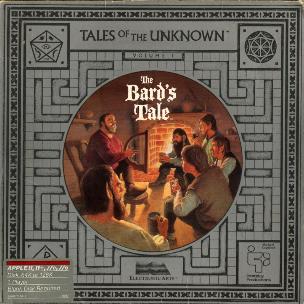
The Bard's Tale is a fantasy role-playing video game designed and programmed by Michael Cranford for the Apple II. It was produced by Interplay Productions in 1985 and distributed by Electronic Arts. The game was ported to the Commodore 64, Apple IIGS, ZX Spectrum, Amstrad CPC, Amiga, Atari ST, DOS, Macintosh, and NES. It spawned The Bard's Tale series of games and books. The earliest editions of the game used a series title of Tales of the Unknown, but this title was dropped for later ports of The Bard's Tale and subsequent games in the series.
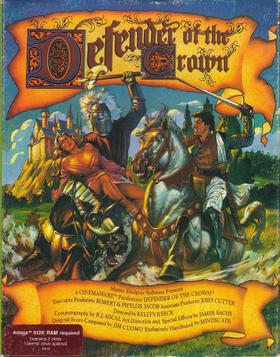
Defender of the Crown is a strategy video game designed by Kellyn Beck. It was Cinemaware's first game, and was originally released for the Commodore Amiga in 1986, setting a new standard for graphic quality in home computer games.

Cinemaware was a video game developer and publisher. It had released several titles in the 1980s based on various film themes. The company was resurrected in 2000, before being acquired by eGames in 2005.

The Bard's Tale II: The Destiny Knight is a fantasy role-playing video game created by Interplay Productions in 1986. It is the first sequel to The Bard's Tale, and the last game of the series that was designed and programmed by Michael Cranford.

Spellbreaker is an interactive fiction computer game written by Dave Lebling and published by Infocom in 1985, the third and final game in the "Enchanter Trilogy." It was released for the Amiga, Amstrad CPC, Apple II, Atari 8-bit family, Atari ST, Commodore 64, Macintosh, and DOS. Infocom's nineteenth game, Spellbreaker is rated "Expert" difficulty.

Stationfall is an interactive fiction video game written by Steve Meretzky and released by Infocom in 1987. It was released for the Commodore 64, Amiga, Amstrad CPC, Apple II, Atari 8-bit family, Atari ST, and MS-DOS,. The game is a sequel to Planetfall, one of Infocom's most popular titles. It is Infocom's twenty-fifth game.

The Eidolon was one of two games that were part of Lucasfilm Games' second wave in December 1985. The other was Koronis Rift. Both took advantage of the fractal technology developed for Rescue on Fractalus!, further enhancing it. In The Eidolon, Rescue's fractal mountains were turned upside down and became the inside of a cave.

Wizardry: Proving Grounds of the Mad Overlord is the first game in the Wizardry series of role-playing video games. It was developed by Andrew Greenberg and Robert Woodhead. In 1980, Norman Sirotek formed Sir-Tech Software, Inc. and launched a beta version of the product at the 1980 Boston Computer Convention. The final version of the game was released in 1981.

Portal is a text-driven adventure with a graphical interface published for the Amiga in 1986 by Activision. The writing is by American author Rob Swigart, and it was produced by Brad Fregger. Ports to the Commodore 64, Apple II, and IBM PC were later released. A version for the Atari ST was announced and developed, but not published. Until recently, it was thought that a Macintosh version was similarly developed yet left unpublished. The published Macintosh version was rediscovered in 2021 by a game collector.
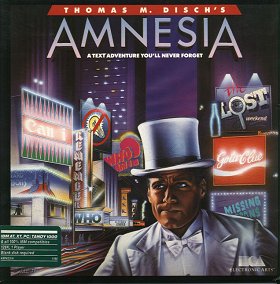
Amnesia is a text adventure written by science fiction author Thomas M. Disch, programmed by Kevin Bentley, and published by Electronic Arts in 1986 for IBM PC compatibles and Apple II. A Commodore 64 version was released in 1987. Disch's ironic, rich writing style is in distinct contrast to the functional or tongue-in-cheek tone of most text adventures. Over half of Disch's novel-length manuscript had to be cut from the published version due to the storage limitations 5¼" floppy disks.

Rebecca Ann Heineman is an American video game designer and programmer. Heineman was a founding member of video game companies Interplay Productions, Logicware, Contraband Entertainment, and Olde Sküül. She has been chief executive officer for Olde Sküül since 2013.
Michael Berlyn was an American video game designer and writer. He was best known as an implementer at Infocom, part of the text adventure game design team. He is also known as the designer behind Bubsy in Claws Encounters of the Furred Kind (1993) and Bubsy 3D (1996).

Spindizzy is an isometric computer game released for several 8-bit home computer formats in 1986 by Electric Dreams Software. It combines action and puzzle game elements. Players must navigate a series of screens to explore a landscape suspended in a three-dimensional space. Development was headed by Paul Shirley, who drew inspiration from Ultimate Play the Game games that feature an isometric projection.
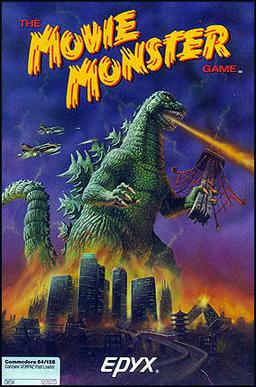
The Movie Monster Game is a computer game released by Epyx for the Apple II and Commodore 64 in 1986. The game offers a variety of scenarios, playable monsters, and cities to demolish. The monsters are based on popular movie monsters such as The Blob, Mothra, the Stay Puft Marshmallow Man, and the Transformers, and Epyx was able to officially license Godzilla.
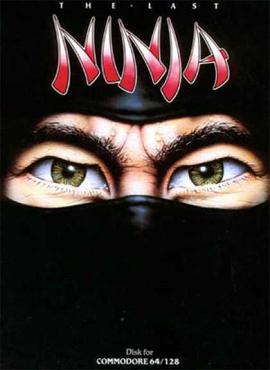
The Last Ninja is an action-adventure game originally developed and published by System 3 in 1987 for the Commodore 64. It was converted to the Apple IIGS, MS-DOS, BBC Micro and Acorn Electron in 1988, the Apple II series in 1989, the Amiga and Atari ST in 1990, and the Acorn Archimedes in 1991.

World Games is a sports video game developed by Epyx for the Commodore 64 in 1986. Versions for the Apple IIGS, Amstrad CPC, ZX Spectrum, Sega Master System and other contemporary systems were also released. The NES version was released by Milton Bradley, and ported by Software Creations on behalf of producer Rare. A Virtual Console version was released in Europe on April 25, 2008.

Space Quest: Chapter I – The Sarien Encounter, commonly known as Space Quest I, is a graphic adventure game released in October 1986 by Sierra On-Line. It is the first game in the Space Quest series. It quickly became a hit, selling in excess of 100,000 copies. Total sales are believed to be around 200,000 to date, not including the many compilations it has been included in.

GBA Championship Basketball: Two-on-Two is a 1986 computer basketball game for the PC, Amiga, Apple II, Apple IIGS, Amstrad CPC, Atari ST, ZX Spectrum and Commodore 64. It was developed by Dynamix and published by Activision.

Shanghai is a computerized version of mahjong solitaire published by Activision in 1986 for the Amiga, Atari ST, Atari 8-bit family, Commodore 64, DOS, Macintosh, Apple IIGS and Master System. Shanghai was originally programmed by Brodie Lockard. It was released as an arcade game by Sunsoft in 1988.




















